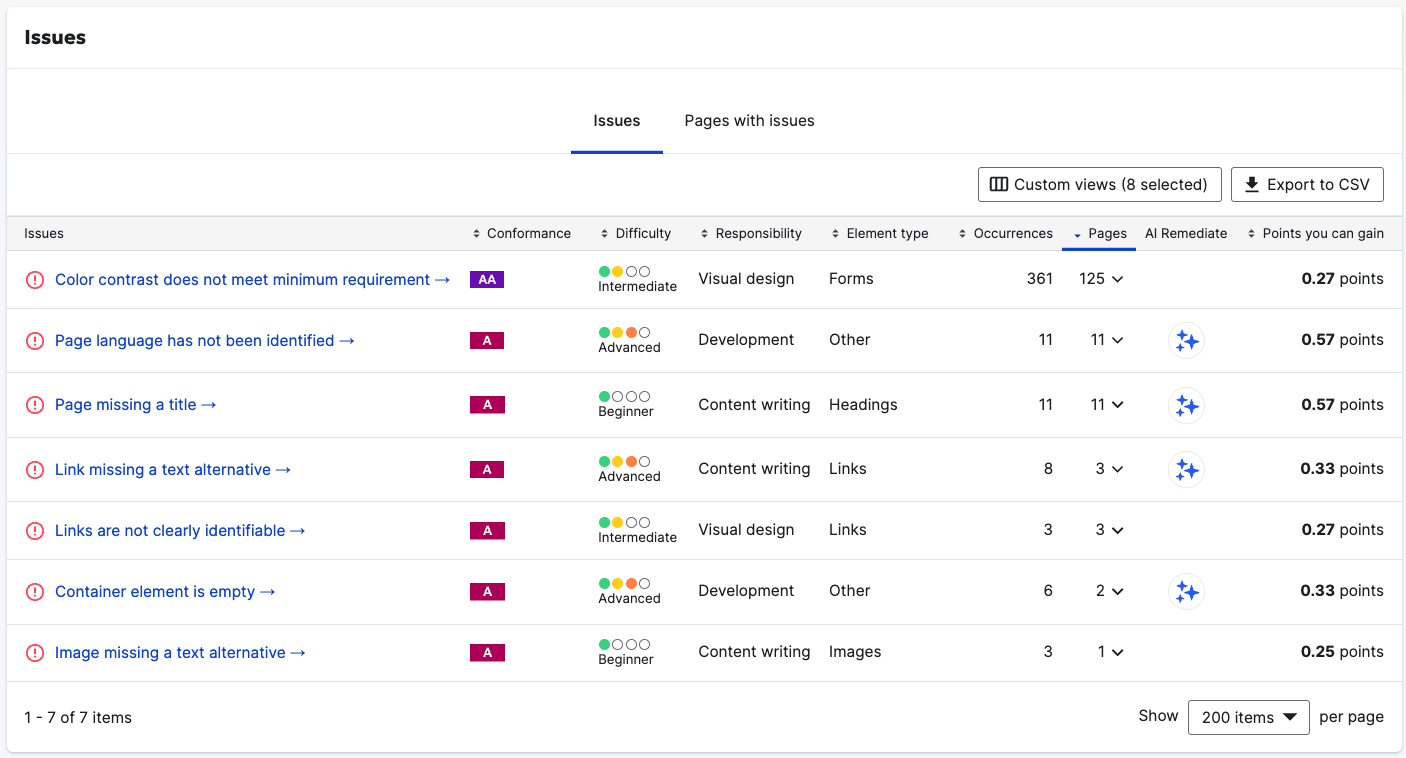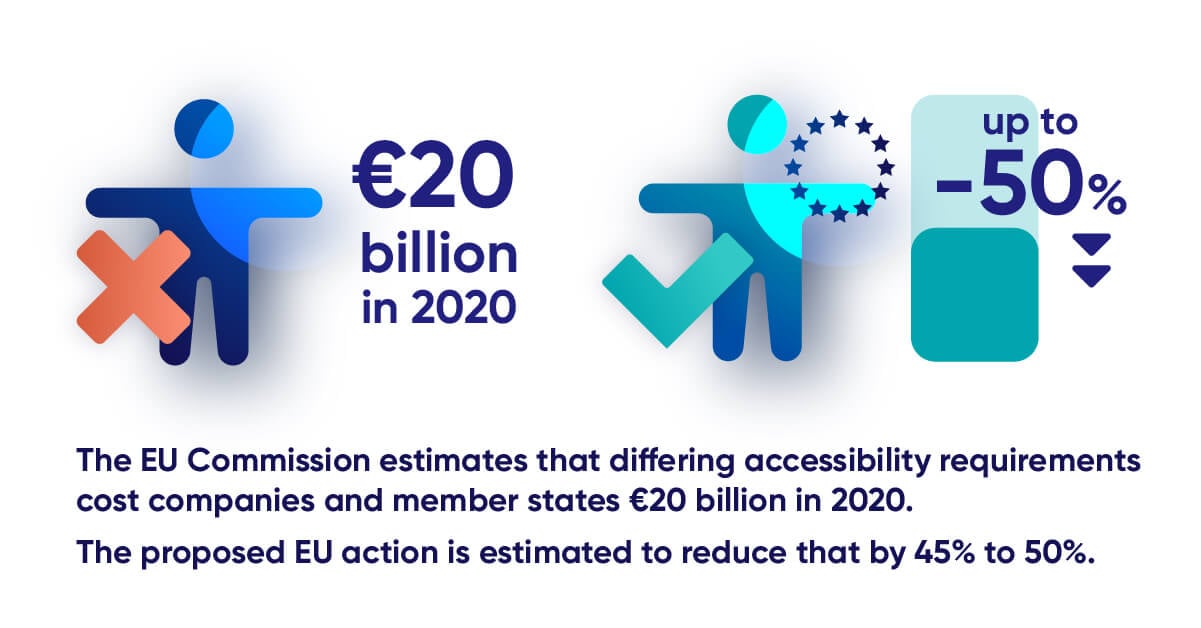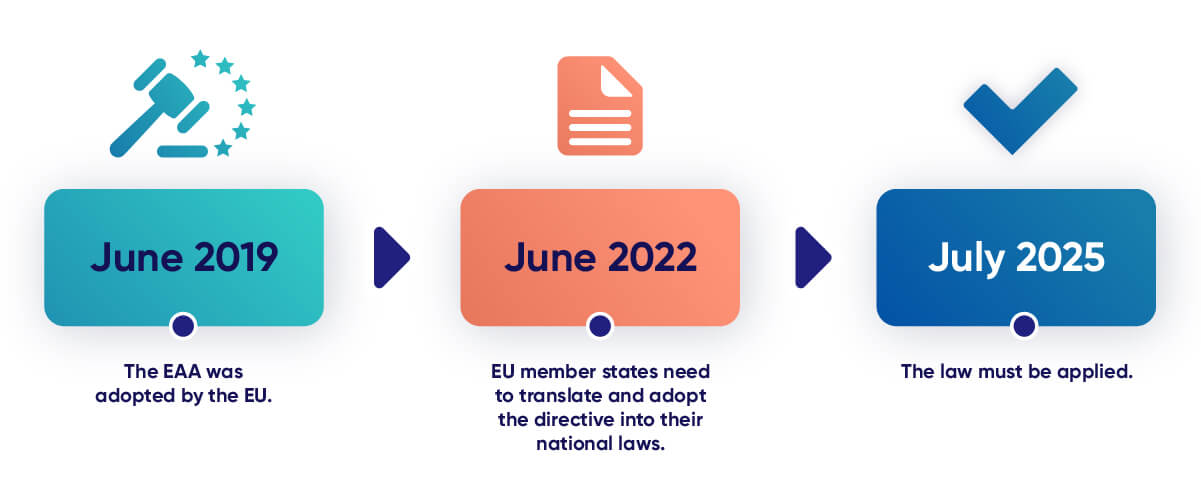There are 135 million people in the EU who have a disability, and that number will only grow as the population ages. To address the rights of those people as outlined by the UN Convention of Rights on the Persons of Disabilities, the EU has passed both the EU Web Accessibility Directive and the European Accessibility Act (EAA).
Most of the deadlines for the EU Web Accessibility Directive have already passed, but if you still have questions about what it means for you, check out our extensive FAQ post on the directive.
In this post, we’ll cover what the newer European Accessibility Act is and what it might mean for your business.
What is the European Accessibility Act?
The EAA (also known as Directive 2019/882) is meant to “improve the functioning of the internal market for accessible products and services, by removing barriers created by divergent rules in Member States,” according the European Commission.
Previously, each member state in the EU had different accessibility standards for products and services. This resulted in poor selection and expensive products for consumers, and small markets with little incentive for companies.
Under the EAA, EU member states will now have a set of common accessibility rules to follow, making it easier for private companies to sell compliant products and services in all areas of the EU, which will increase selection for consumers.
The goal of the act is to harmonize and standardize accessibility rules, so that products and services use a “design for all” approach. According to the UN Convention of Rights on the Persons of Disabilities, that approach “means the design of products, environments, programs and services should be usable by all people, to the greatest extent possible, without the need for adaptation or specialized design.”
The act also says that apps and websites should be made accessible with the four principles of accessibility in mind (POUR): perceivable, operable, understandable, and robust. Those principles are what WCAG is built on, which is the universal standard for web accessibility.
The web must be clear. Laws demand it. Siteimprove finds the problems on your pages, and it helps you fix them so you stay right.

Concerned About the European Accessibility Act? Get clear answers and practical resources to achieve compliance. Our EAA Resource Center provides expert insights, checklists, and tools to guide you every step of the way.
Who does the EAA apply to?
Unlike its companion directive, the EAA applies to private companies selling products or services that are seen as highly important for disabled people, and have widely ranging accessibility requirements across the member states. The EAA applies to private businesses operating in the EU with over 10 employees and an annual turnover above €2M.
The EAA applies to products and services that are sold or used within the EU, regardless of where those businesses are based. If your business markets to or serves users in the EU, the EAA applies, regardless of your HQ location.
- Does the EAA apply to UK businesses? The EAA is EU legislation. UK companies are not required to comply unless they offer goods or services to EU customers. However, aligning with EAA standards is advisable for businesses serving or targeting the EU market.
- What about UK government organisations or charities? UK Government entities follow UK-specific accessibility regulations. However, if they serve EU markets, they must comply with the EAA.
- How does the EAA affect B2B companies? While B2B isn't explicitly mentioned, procurement expectations are rising. If your clients or customers are required to comply, they will likely require accessible tools from you.
- Does the EAA apply to B2B-only industries, like insurance or industrial manufacturing? Yes, if their services fall within scope (e.g., banking, e-commerce) or if their public-facing sites provide product or service info.
- What level of accessibility is needed in higher education or public sector? Many in these sectors are already aligned with WCAG 2.1 under national law due to the EU Web Accessibility Directive. The EAA introduces additional obligations if you're in the private sector or operate cross-border.
Basically, the EAA is meant to standardize the most important products and services for disabled people. The act covers hardware, software, web, and services:
- Computers and operating systems
- ATMs, ticketing, and check-in machines
- Smartphones and tablets
- TV equipment related to digital television services
- Telephony services and related equipment
- Access to audio-visual media services such as television broadcast and related consumer equipment
- Services related to air, bus, rail, and waterborne passenger transport (websites, apps, ticketing services, etc.)
- Banking services
- eBooks and eReaders
- Emergency numbers
- Ecommerce websites and apps
What are the benefits of the act?
For companies and member states
Previously, companies would create products or services that were compliant with the accessibility requirements for one or a few countries. That made the selection of products/services less competitive and lowered the incentive for companies to make accessible products.
The EU Commission estimates that differing accessibility requirements cost companies and member states €20 billion in 2020. The EU action is estimated to reduce that by 45% to 50%.
With a standard set of accessibility rules, companies can offer products/services that are compliant within the whole of Europe, which greatly increases their market reach and incentive to create accessible offerings.
Beyond compliance, accessibility enhances customer experience, brand trust, and operational efficiency. According to Forrester, 65% of marketers see accessibility tools as crucial to their success. Accessible products can reduce complaints, lower support costs, and increase customer loyalty. Accessible products are easier to use for everyone, improving overall satisfaction.
For consumers
For all consumers, there are now more choices and products/services are better and more competitively priced, all thanks to the EAA.
The act will also supports independent living for people with disabilities, as there are more accessible products and services to rely on.
Other benefits of the act include:
- More employment opportunities for disabled people to work with creating accessible products/services
- Harmonized accessibility requirements will allow companies to better share research, technology, and ideas that everyone can benefit from
- A strong requirement in the EU for a standardized level of accessibility leads other countries to adopt the same standards so they can easily sell products/services in the EU
- Disabled people can enjoy more freedom of movement and employment between member states as they can count on standardized levels of accessibility
- The elderly, people with temporary disabilities, people traveling with luggage, etc. all benefit from more accessible services and devices
- A single market for accessible products and services means lower prices, more choices, and more innovation

What's the timeline for the EAA?
The EAA was adopted by the EU in June 2019. By June 2022, EU member states need to translate and adopt the directive into their national laws. As of June 28, 2025 the law is enforced.

What is the transition period for compliance?
Content published before June 28, 2025 must comply by June 28, 2030. Any new content after June 28, 2025 must comply from launch.
What accessibility standard does the EAA require?
The EAA references EN 301 549, which incorporates WCAG 2.1 AA as the web standard. WCAG is the universal standard for web accessibility, built on the POUR principles.
- Is WCAG 2.2 AA acceptable for compliance? WCAG 2.2 includes and builds on WCAG 2.1. While not currently mandated by EN 301 549, it is a smart target for future-proofing.
- What about EN 301 549 criteria beyond WCAG? These include additional requirements (e.g., documents, multimedia). Compliance can be complex and may vary by country. When in doubt, consult accessibility experts or local regulations.
- What level of compliance is expected by the deadline? WCAG 2.1 AA for web content is the baseline under EN 301 549 by the deadline.
- Is keyboard navigation required? It is a core WCAG 2.1 AA requirement and essential for EAA compliance.
- Are ARIA roles required? ARIA roles aren't mandatory but help meet many WCAG success criteria and are considered best practice.
- Do multilingual sites need alt text in each language? Alt text and other accessible elements should be localized to match the language of the page.
- Do PDFs and downloadable documents need to comply? Yes, if they are public- facing. Use accessible PDF formats and test using screen readers.
- Can AI make PDFs or InDesign documents accessible? AI tools can assist, but full compliance typically requires manual checks and remediation.
Who is exempt from the European Accessibility Act?
There is an exception in the act for “undue burden,” meaning a company doesn’t have to comply if it would change the nature of the product/service or if the company would be financially overburdened.
There’s also an exception for what the act calls “micro-enterprises,” which are companies with less than 10 employees and an annual turnover of less the two million euros.
There are a few specific instances that are exempt from compliance:
- Pre-recorded time-based media published before June 2025
- Office file formats published before June 2025. (However, public-facing documents do need to comply).
- Online maps, if essential information is otherwise provided in an accessible way
- Third party content that is not funded, developed, or under the control of the organization that has to be compliant. However, you are responsible for accessibility if third-party services are part of your customer journey. Add accessibility clauses in vendor contracts.
- Archive content that won’t be updated after June 2025
- Social platforms themselves are not directly covered. However, your content on these platforms should follow best practices (e.g., alt text, captions) for brand consistency and user experience.
How is the European Accessibility Act enforced?
Each member state is in charge of enforcing the act, which means they can appoint the body in charge of enforcement and decide penalties.
- Penalties: Member states are in charge of enforcing their own penalties for noncompliance, which should be “effective, proportionate, and dissuasive.” Penalties vary by country and can be up to €3 million.
- Reporting noncompliance: Each member state must make it possible for consumers to report noncompliance to either the courts or the body in charge of enforcing the law in that country. Both public and private organizations also must have the option of going to court or filing a complaint with the body in charge.
- What accessibility score is "good enough" to avoid penalties? There is no set "score". Full compliance with WCAG 2.1 AA is expected. While 80%+ automated checks are a good internal target, manual testing is essential. Regulators may still act on individual complaints.
What’s the difference between the EU Web Accessibility Directive and the European Accessibility Act?
The EAA applies to private businesses (or public organizations offering the type of products/services listed), while the EU Directive applies to public organizations and the third-party vendors they use. Beyond that, the EAA applies to hardware, software, and web, while the EU Directive applies to web and apps. However, public sector entities operating cross-border or offering the types of services listed under the EAA may have additional obligations under the EAA.
The EU Directive specifically references WCAG 2.1 Level AA, while the EAA references EN 301 549, which incorporates WCAG 2.1 AA as the web standard. The deadlines for each regulation are also different.
The way the regulations are implemented is the same: member states are responsible for enforcing, imposing fines, and reporting status to the European Commission.
Start achieving accessibility excellence
The EAA is a huge step forward for EU members states and people with disabilities within the EU. The legislation creates better choices at better prices for people with disabilities, but it also makes products, services, and websites more usable for all people.
If you’re unsure how to start your accessibility journey, consider this 10-step process:
- Understand the requirements (EN 301 549 + WCAG).
- Conduct a current-state audit.
- Develop internal policies.
- Train teams.
- Integrate accessibility into design/development processes.
- Implement fixes.
- Monitor compliance.
- Document your efforts.
- Engage users and stakeholders.
- Stay current with evolving standards.
You can head over to Siteimprove's EAA Resource Center for free tools, resources, tips, and more. While the Siteimprove platform doesn't yet have a dedicated "EAA" flag, Siteimprove audits for WCAG 2.1 AA, which is the core web standard under the EAA. An EAA dashboard or report is under consideration and development; in the meantime, use WCAG settings
